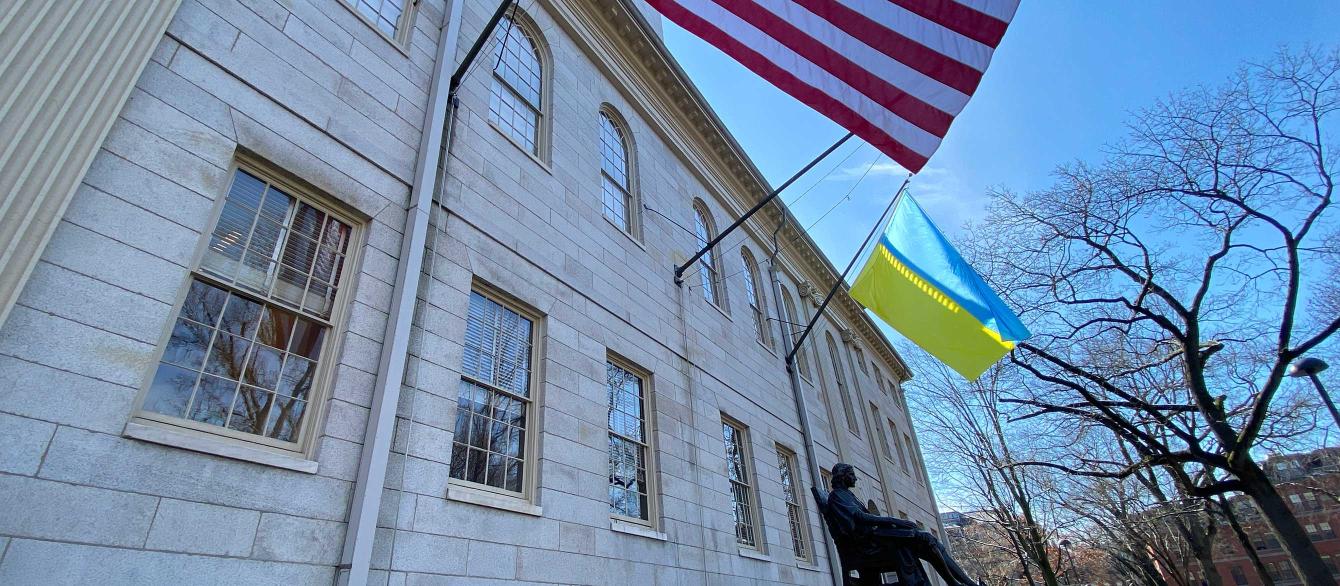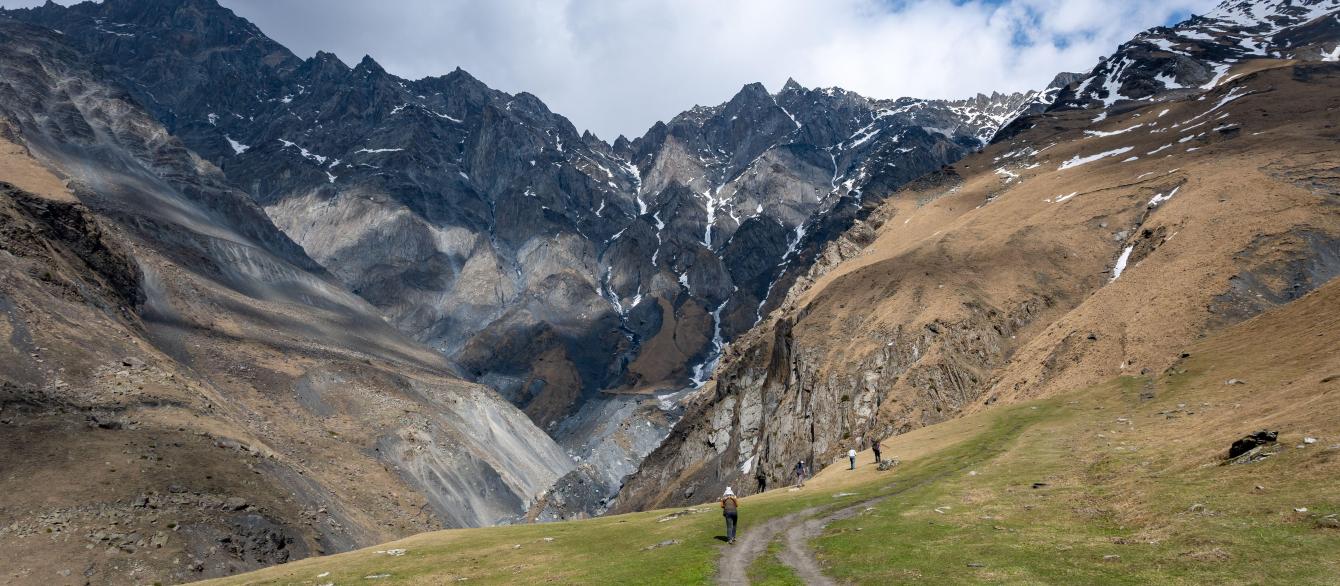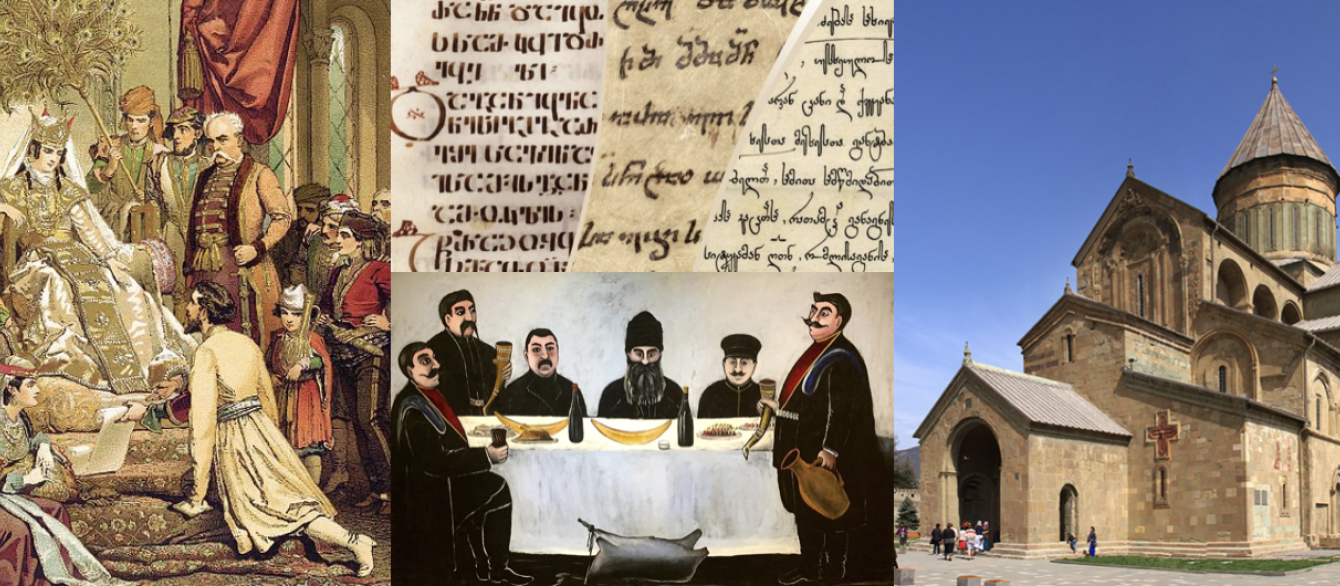Left: a work painted by Mihály Zichy, the picture depicts Rustaveli presenting his epic to King Tamar. Impressed by the poem, the artist donated all of his 35 paintings to the “Georgian people.” Top Center: the asomtavruli, nuskhuri and mkhedruli alphabets. Only mkhedruli is in current use. Bottom Center: The Feast, by Niko Pirosmanishvili. Right: Svetitkhoveli Cathedral, a medieval Eastern Orthodox cathedral in Mtskheta, Georgia.
Please contact GeorgianStudies@fas.harvard.edu with any questions or concerns, as well as suggestions for the Cultural Highlights of Georgia. You can also contact RA Nini Sikharulidze directly at nsikharulidze@college.harvard.edu.
Contents
- Deda Ena
- Dmanisi Historic Site
- Folk Dance
- Georgian Chokha
- Georgian Cinematography
- Georgian Cuisine
- Georgian Script
- Ivane Javakhishvili Tbilisi State University
- Polyphonic Singing
- Svetitskhoveli Cathedral
- The Knight in the Panther's Skin
- Wine-Making Tradition in Georgia
Deda Ena
Iakob Gogebashvili (1840-1912), Georgian educator, writer and journalist, compiled and published Deda Ena in 1876. The name translates to “Mother Tongue.” Deda Ena was a collection of literary texts designed by Gogebashvili to promote the Georgian language at a time when the study of Georgian was discouraged, banned and seen as a source of resistance to Russia’s “superior” culture. Deda Ena has gone through multiple editions, and is used to this day for teaching Georgian in schools. A symbolic aspect of Georgian identity, Gogebashvili’s primer was inscribed on the Intangible Cultural Heritage of Georgia registry in 2013.
Dmanisi Historic Site
A town and archaeological site in Georgia, Dmanisi is a hominid site going back 1.8 million years. The early human fossils found in the area are considered Homo erectus georgicus, now believed to be a subspecies of Homo erectus. Dmanisi fossils represent the earliest known human presence in the Caucasus region. Their discovery supports the Out of Africa hypothesis that all modern humans are descended from Homo sapiens who emigrated from Africa to Eurasia.
Folk Dance
Georgian folk dance has a long history. Archaeological evidence suggests that the earliest folk dances in the region were hunting dances performed in honor of fertility gods like Shushpa. Excavations in Trialeti have revealed evidence of dance rituals, similar to the ancient Perkhuli dance. The combination of sacred dance elements with martial rituals, sports and religious traditions led to the creation of dances like the Kartuli, Acharuli, Khorumi and Mtiuluri. Georgian dance is a source of Georgian artistic pride. Iliko Sukhishvili and Nino Ramishvili founded the National Georgian Ballet dance group which popularized Georgian folk dance internationally.
Georgian Chokha
The chokha is an important element of Georgian national clothing. A woolen coat with cartridge casings on the chest, the chokha made its appearance in Georgia around the 9th century. Worn in other regions of the Caucasus, chokhas come in different shapes, sizes and colors. Three types of chokhas – the Kartl-Kakheti, the Khevsur and the Acharian – are the most common regional versions. To this day, chokhas are frequently encountered at wedding ceremonies, funerals and other important events.
Georgian Cinematography
Georgian cinema is known for its cinematography all around Europe. The first movie screening in Tbilisi with Lumière apparatus took place on November 16, 1896, just months after the first Lumière film screening in Paris and St. Petersburg. In 1912, Vasil Amashukeli (1886-1977) depicted Akaki Tsereteli’s, a prominent national poet and liberation movement figure, journeying in Racha-Lechkhumi, and created the first full-length (about 1200m of film) Georgian documentary (Journey of Akaki). The first Georgian feature film Christine was based on a short story by Egnate Ninoshvili (1859-1894), a Georgian writer and social democratic activist. Importantly, both Journey of Akaki and Christine are commemorations of Georgian national poetry and literature, a method that many Georgian filmmakers utilize to showcase Georgian culture and pride. Georgian cinema has countless movies of merit, such as The Eccentrics (1973), The Wishing Tree (1976), Blue Mountains (1983), Repentance (1986), The Sun of the Sleepless (1992), and newer emerging masterpieces, such as Tangerines (2013) and Corn Island (2014).
Georgian Cuisine
A central aspect of Georgian tradition is the “supra,” a Georgian feast held on important occasions. A “supra” is not complete without a Tamada, or a toastmaster, the person in charge of leading the toasts. Traditionally, the Tamada opens the feast with a toast to the homeland, and then to God, before shifting to guests.
Georgian hospitality, the “supra,” and toast making would be incomplete without the diversity and richness of taste that characterizes Georgian cuisine. With the inclusion of various spices, organically grown vegetables, and rich fillings and sauces, Georgian traditional dishes offer a culinary adventure.
Individual historical provinces of Georgia have their own method of preparing traditional dishes like Khachapuri (Georgian cheese bread). Chopped vegetarian dishes (Pkhaleuli) are characterized by spiced plants and unique seasoning, while poultry dishes like satsivi are known for the exotic taste of meat brought out by walnut and garlic sauces. A particularly popular meat dish is khinkhali, meat dumplings with a rich meaty juice and eaten by hand. A peculiar national dessert is churchkhela, which is threaded walnuts dipped in hot grape mixture.
Georgian Script
Asomtavruli, nuskhuri and mkhedruli are all recognized by UNESCO. “The living culture of three writing systems of the Georgian alphabet” satisfied all criteria for inclusion in the Representative List of the Intangible Cultural Heritage of Humanity in 2016.
Although the oldest Georgian inscriptions date back to the fifth century AD, many historians debate the time of their first appearance. Leonti Mroveli, the ninth century Georgian historian and the author of kartlis tskhovreba, a collection of Georgian medieval historical texts, dated the creation of the Georgian alphabet to King Parnavaz (Third/Second century BCE) who, he claimed, extended the language throughout Georgian territories. Ivane Javakhishvili, the Georgian historian and linguist as well as a founder of Tbilisi State University, argued that the Georgian alphabet and its writing system was already in place by the 7th century BCE.
The modern Georgian script – mkhedruli (literally meaning “knightly”) – was preceded by the more rounded forms of asomtavruli and the decorative characters of nuskhuri. Mkhedruli has changed very little since its first appearance in the ninth and tenth centuries AD, and is one of only 14 existing alphabetic scripts in the world. The asomtavruli and nuskhuri alphabets are informally practiced and are often taught in Georgian schools. They are predominantly used by the Georgian Apostolic Autocephalous Orthodox Church.
Ivane Javakhishvili Tbilisi State University
Ivane Javakhishvili Tbilisi State University (TSU) is the oldest university in Georgia and the Caucasus region, founded on February 8th, 1918 in Tbilisi, Georgia. Georgian intellectuals and social figures like Ekvtime Takaishvili, Giorgi Akhvlediani, Shalva Nutsubidze, Dimitri Uznadze, Grigol Tsereteli, Akaki Shanidze, Andrea Razmadze, Korneli Kekelidze, Ioseb Kipshidze and Petre Melikishvili co-founded the university. Before Georgian independence in 1918, there was no opportunity for higher education in Georgian territories under Russian control. Since Georgian independence in 1991, higher education in Georgia has expanded, and currently there are over 56 universities in Georgia, 29 of them private.
Polyphonic Singing
Georgian polyphonic singing has been inscribed on the Representative List of the Intangible Cultural Heritage of Humanity since 2001. Polyphonic singing is an important tradition for Georgians as it helped preserve Georgian language and culture when the country was occupied by invaders. Some songs still performed today date back to the eight century. Georgian polyphonic songs are “lifestyle” songs, sung during harvesting or at funerals and during festivities.
“Chakrulo” is a Georgian polyphonic battle song, included in the Golden Record of 27 selections of world music that was sent into deep space on two Voyagers on August 20 and September 5, 1977. The Golden Records were meant to showcase the diversity of life on Earth to any intelligent extraterrestrial life out in the galaxy.
Svetitskhoveli Cathedral
Located in Mtskheta, Georgia’s ancient capital at the confluence of the Aragvi and Mtkvari Rivers 20 km. northwest of Tbilisi, Svetitskhoveli cathedral is a powerful monument to medieval Georgian architecture. Svetitskhoveli cathedral, along with the Holy Cross Monastery of Jvari and Samtavro Monastery, is recognized by UNESCO as a World Heritage Site.
The historical monuments of Mtskheta illustrate the diffusion of Christianity to the Caucasus, and embody a history of human settlement in the region since the late 3rd millennium BCE. The churches depict the evolution of ecclestiastial art from the 4th to the 18th centuries.
Svetitskhoveli was the coronation site of Georgian monarchs as well as a place of royal burial. Vakhtang Gorgasali, a canonized Georgian king who ruled in the 5th-6th centuries, founded the modern capital of Georgia, Tbilisi. His burial site is in Svetitskhoveli cathedral. Svetitskhoveli cathedral is recognized by Georgians as the burial site of Christ’s mantle, making it a sacred place for Christians.
The Knight in the Panther's Skin
Written by Georgia’s national poet Shota Rustaveli, The Knight in the Panther Skin used to be an essential part of the dowry of every noble Georgian bride. A Georgian medieval epic poem depicts fictional adventures in India and Arabia, which represent allegorical settings of the rule of the popular King Tamar of Georgia, the first woman to rule Georgia with a title of a King. Emphasizing the glory of Georgia’s Golden Age during King Tamar’s rule (12th and 13th centuries AD), 1600 Rustavelian Quartains embody values of devotion, conscience, courage, friendship and love. Excerpts from The Knight in the Panther Skin make up an essential part of the Georgian language curriculum in Georgia’s educational institutions.
Wine-Making Tradition in Georgia
Known as the cradle of wine, Georgia boasts a wine-making culture dating back to 6,000 BCE. The wine earthenware pot called a “qvevri,” is buried underground for up to 50 years to produce and preserve Georgian made wine. An important part of Georgian culture, wine is central to Georgian art and architecture. The ancient Georgian traditional qvevri wine-making method has been included (in 2013) in the Representative List of the Intangible Cultural Heritage of Humanity (UNESCO). With more than 500 different endemic grape varieties, Georgia makes good quality wine, including Saperavi, Kindzmarauli, Tsitska-Tsolikauri, Khvanchkara and Rkatsiteli.




